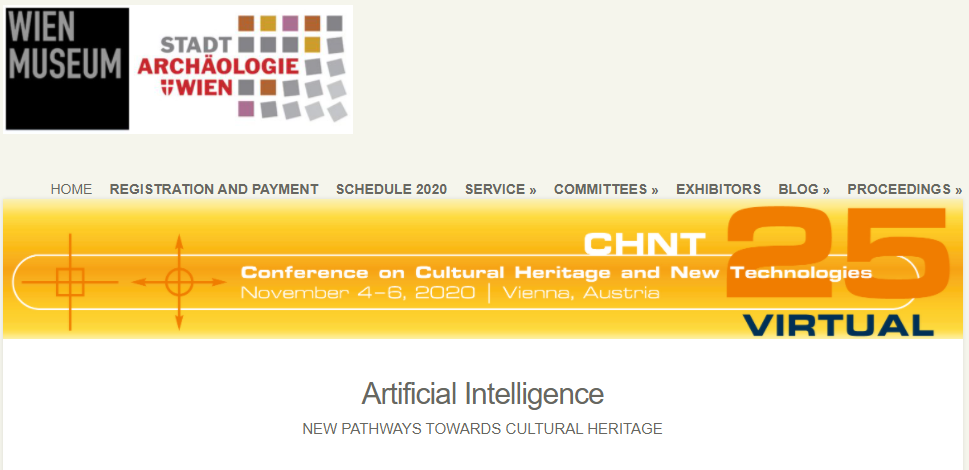25th CONFERENCE ON CULTURAL HERITAGE AND NEW TECHNOLOGIES (CHNT) ONLINE

On November 4-6, 2020, Cristina Mosconi and Dr Pikakshi Manchanda of the University of Exeter attended the 25th annual conference on Cultural Heritage and New Technologies (CHNT 2020). Traditionally hosted in Vienna, this year for the first time in its long history, the conference was held virtually. Despite its virtual location, the conference was attended by over 300 participants, whose nationalities covers all the continents. Centered around the theme of “Artificial Intelligence: New Pathways towards Cultural Heritage”, the conference aimed to showcase best practice AI applications but also discuss the potential and limits of various AI approaches. Started with the ritual opening speech by Vienna authorities (this year, Matti Bunzl, Director of the Wien Museum), over three days, the conference has welcomed 11 sessions, 7 round tables, 3 training spaces and the long-established Poster and App Awards.
Of particular interest was the opening key note by Eslam Nofal (Maastrich University, The Netherlands), whose presentation on ‘Phygital Heritage’ proposed a novel mix-methods approach for assessment of heritage communication and user engagement with digital interpretation. His research on experience evaluation, as well as the interactive prototypes proposed as case studies, goes in the same direction of our VISTA AR ‘DataSphere’, where a combination of several parameters and techniques are deployed to understand the visitor throughout the different phases of the site visit.
Cristina (active participant at CHNT since 2017 and a member of the CHNT Scientific Committee) and Pikakshi (participant since 2019) were the co-chairs of a round table (RT) session titled “Integrating Artificial Intelligence in Cultural Heritage sites’ audience research”; the goal of which was to start a conversation about the adoption of Artificial Intelligence technologies for conducting audience research. A research team from Massachusetts Institute of Technology, USA working with the world heritage site Machu Picchu also participated in the Round Table.

The key discussion points for the RT were:
– How Artificial Intelligence can help in identifying and targeting the selected audience?
– In what ways can AI help to inform and shape existing business models?
– How can AI support the offers of innovative digital solutions compatible with the organisational and economic characteristics of CH sites?
The RT started with an introductory presentation on the VISTA AR project and its Text Analytics, which was followed by a case-based description of the use of AI technologies at various sites in the project such as Exeter Cathedral to track visitor experience. Cristina discussed the role of eye tracking and geo-spatial tracking approaches in understanding the visitor’s engagement and behavioural patterns during the journey at a heritage site.

Cristina’s case-based talk was followed by the presentation from Takehiko Nagakura and Paloma Gonzales, researchers at the Architecture Department of the Massachusetts Institute of Technology (USA). Here, they presented their latest research results of tracking and simulating pedestrian trajectories at the archaeological site of Machu Picchu, Peru. Their work focuses on simulation of walking paths within the site using Artificial Intelligence technologies, such as machine learning models.
Their design of the AI based navigation model is very relevant during the current pandemic. Alike our research on geospatial and eye-tracking, their work is showing the great potential that AI technologies has for designing and managing the cultural heritage sites, including its circulation planning, congestion relief and capacity control, and social distancing.

MIT’s presentation encouraged an active discussion among everyone about the applications of their research and the impact on visitor experience. This was followed by a presentation on data-driven dashboards for heritage sites by Pikakshi. She discussed the role of dashboards in providing access to visitor intelligence to site managers which can be used for decision making when it comes to evaluating the experiences the site has to offer. Pikakshi, using the case study of Exeter Cathedral, presented the benefits of unifying numerous sources of visitor information – such as visitor movements, and visitor text feedback – within a dashboard in order to generate a clearer picture of the visitor’s experience and identify the pain points. This talk inspired a detailed discussion around the pros and cons of using visitors’ unsolicited (written) feedback, for instance, to understand visitor motivation and experience.

Both presentations were well received by the round table participants. Perhaps the birth of future collaborations with the MIT research team…
